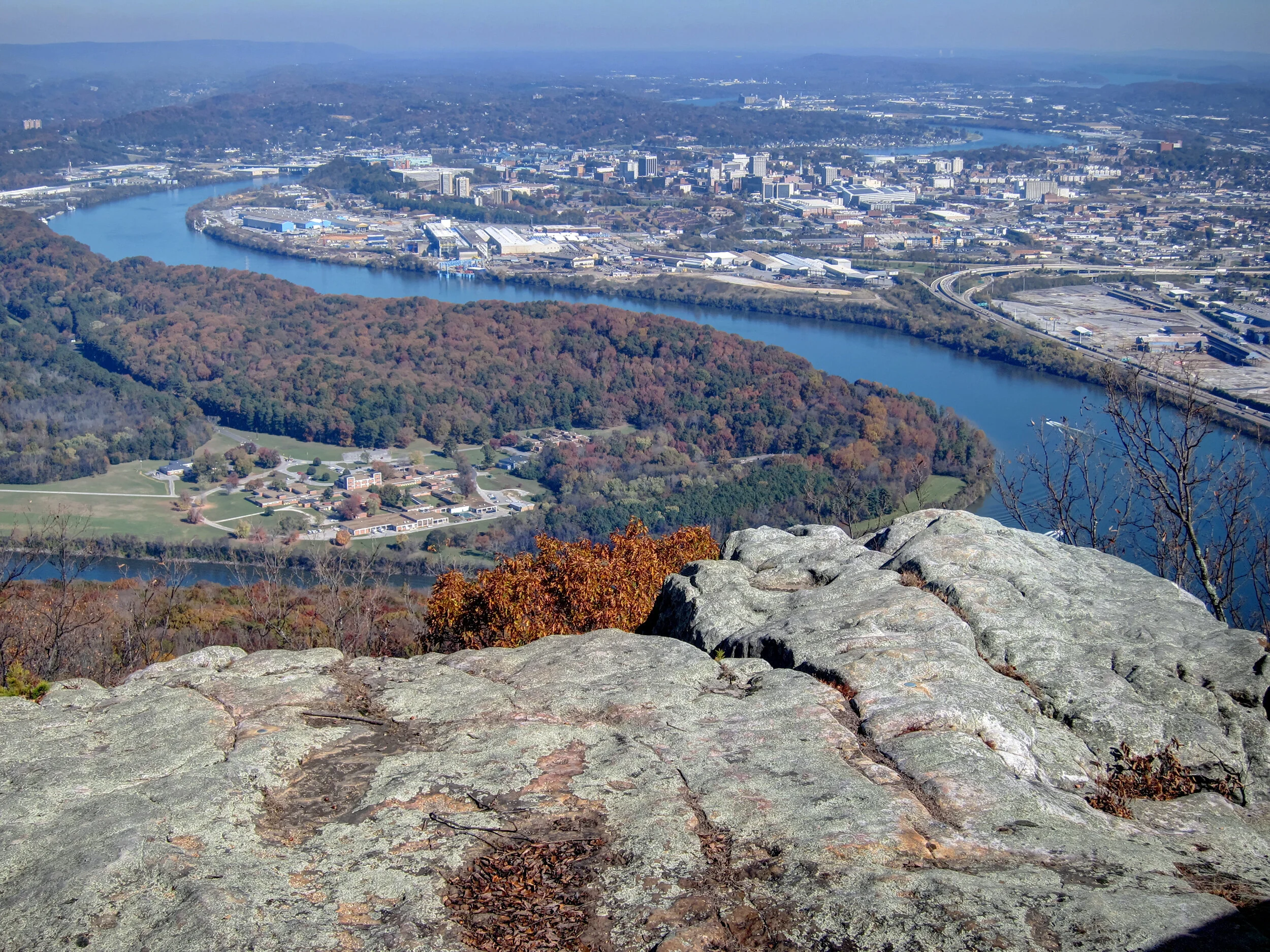
Page 2 of 6
Lookout Mountain, Tennessee
Blue lights on the runway, I love the color of it all
There is more to Lookout Mountain (near Chattanooga, Tennessee) than just seeing Rock City. There's a great little National Battlefield Historic Site (the high ground was a good way to protect the city from northerners like me) and then there's Ruby Falls, a roadside attraction deep inside the mountain. Regular guided tours take the elevator down and spend about an hour and a half (or so) traversing rather tight little caverns until you see what you came to see in the first place. To build the drama, you first enter a rather dark cavern where you know something is going on, things like a much higher ceiling (you can really start to feel volume down there) and more importantly the sound and feel of rushing water start to clue you in that you're near the falls. Then the tour guide flips a switch and cheesy triumphant music starts and colorful lights turn on- and while that cheesy triumphant music is almost always unwelcome, the initial revelation as the colorful lights first turn on is actually quite impressive, although of course it's not nearly as impressive as the cavern chamber and falls themselves.
Throughout that part of the south, it is hard to avoid the See Rock City advertising campaign, first made popular by paintings on barns and now in brochures and on billboards and in post apocalyptic books (see the all cannibalism all the time Cormac McCarthy book "The Road" for more on that). If you do actually go and see Rock City as I have (and had, this wasn't my first visit), you'll not only see seven states but also walk through some often interesting rock formations and along side cliffs and caves as you walk a well tourist traveled trail. More fun (at times) than it probably should be.
While you can actually see seven states from Lookout Mountain, this isn't one of them. This is the missile park at White Sands (New Mexico), where photography was allowed as long as it was only taken in one direction, at least according to the heavily armed military guards. The White Sands Missile Range is important for a lot of reasons, not many of them good. It is generally considered (for good reason) as the birthplace of the Nuclear Age, the first ever nuclear weapon test (code named Trinity) took place at White Sands at a still restricted area that is only open to the public once a year. I'm not sure exactly why you would need to see that site, with the possible exception of looking around and hoping to find mutant and still radioactive three headed zombie desert jackrabbits, something which admittedly does sound pretty damn cool when you start to think about it.
The other claim to fame (and for me the one that is actually more impressive) is that this is where Werner von Braun launched all of those V-2 rockets which were designed in Nazi Germany (he was a Nazi during WW2) that eventually led to the US Space Program. You know Werner von Braun not just for the broad parody of him in Dr Strangelove (easily one of my favorite movies ever) but also for "Gravity's Rainbow" by Thomas Pynchon, easily my favorite (and the best) book I have ever read. "Gravity's Rainbow" begins with a quote from von Braun ("Nature does not know extinction; all it knows is transformation...") and ends with an especially disturbing V-2 rocket launch at Peenemunde, with a plot that is about V-2 rockets more than it is about Tyrone Slothorp or Roger Mexico or the Schwarzgerat, and a semifictional Werner von Braun, who is one of the many hundreds of characters that are hard to forget, no matter how hard you may try. If you have a lot of time and are feeling ambitious I still can't recommend reading "Gravity's Rainbow" enough, although be warned that it's a lot harder to read (and a lot more disturbing in a lot of ways) than you probably think.
Built for a Vanderbilt (does it really matter which one when you really think about it), Biltmore Manor is a now tourable estate in the hills and mountains near Asheville, North Carolina. The house is well designed if you take away all of the excessiveness and the grounds were well designed by Fredrick Law Olmstead, famous (with Calvert Vaux) for designing New York's Central Park and a leading character in Erik Larson's "The Devil in the White City" for his role in the landmark 1893 World's Columbian Exposition in Chicago.
A note about the photos- all of the images in this e-mail were taken with my (then) brand new Canon S90 point and shoot, as good of a point and shoot as I've ever had, or, to be more accurate, the best point and shoot camera out there. I still use my trusted Canon 20D DSLR, although I'm doing what I can to mix them up and just take my point and shoot on some of the trips (the DSLR is fairly bulky so I now take it only on special trips where I know I will really appreciate its range).
The downtown Oklahoma City Art Museum is reasonably well designed (in an 1980s sort of way) and features a smattering of passable art, but it's star attraction is easily a permanent collection of crowd pleasing glass by Dale Chihuly. It may not be art (Chihuly only directs the glass production which is created by a rather large staff) but it is often pretty and seemingly everywhere. And while you can see seven states at Rock City, you can see permanent Dale Chihuly glass exhibitions in twenty four states, at least according to the wildly incomplete list at Wikipedia.
There may be better botanical gardens in other cities, but the botanical gardens (and crystal bridge) in Oklahoma City isn't that bad. In fact Oklahoma City itself really isn't that bad, despite being the world headquarters of Sonic (the burger place, not the hedgehog). There is the terrorism memorial and a crazy looking building by John Johansson and at least one great big tiki head wearing a great big santa hat. There may be more great big tiki heads wearing great big santa hats throughout the city I guess, but in my all too short time there I only found the one.

